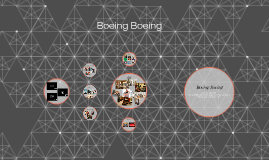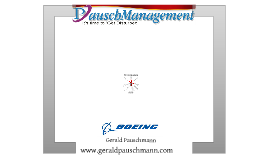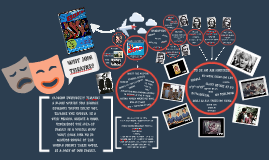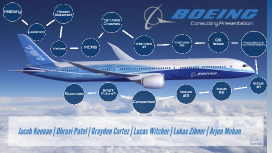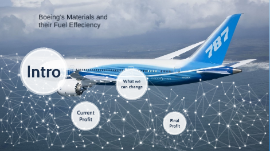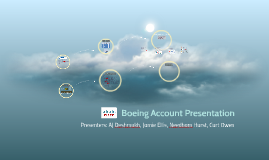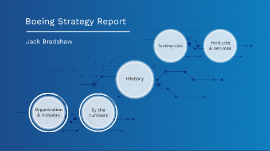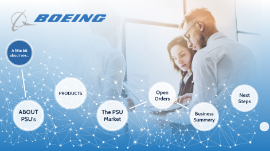Boeing Consulting Presentation
Transcript: Consulting Presentation Jacob Keenan | Dhruvi Patel | Graydon Cortez | Lucas Witcher | Lukas Zibner | Arjun Mohan Boeing Founding Boeing was founded by William Boeing and George Conrad Westervelt in 1916 BMW, the company’s first plane was a single-engine two-seat seaplane Provided 50 planes to the U.S Navy during WWI Secured contracts to supply airmail service and later passenger services Split into three different companies: Boeing Airplane Company, United Airlines, United Airlines Corporation Built military aircraft for WWII, became the top defense contractor It is currently the world’s largest aerospace company and leading manufacturer of commercial jetliners, defense, space, and security system History Leadership Roles Current CEO: Dave Calhoun Leadership Board of directors include: Robert A. Bradway, David Gitlin, Ronald William etc. Mission Statement The Boeing Mission Statement “To connect, protect, explore, and inspire the world through aerospace innovation.” Boeing Values They have a strong engineering foundation to build and maintain their products with safety, quality, and integrity in the factory and in service. They take accountability for every aspect of their work. They strive to do most things right the first time, every time. They reward predictability and stability everywhere in their business. They foster a culture grounded in humility, inclusion, and transparency. They retain the confidence of their customers, suppliers, and investors by communicating with transparency. Values What is MCAS? MCAS Maneuvering Characteristics Augmentation System Flight stabilizing feature on the Boeing 737 MAX Retrofitted model with larger and more fuel efficient jet propulsion turbines Caused the nose to be pushed up during certain maneuvers (especially during take-off) Implemented MCAS software to avoid: Costly restructuring FAA mandated pilot training Requested FAA remove MCAS from manual Fully reliant on a single sensor: Angle of Attack Sensor MCAS Diagram AOA Sensors Airbus Competition Order of Events 2016: FAA approved Boeing's request to remove references to a new MCAS from the flight manual October 29, 2018: Lion Air Accident March 10, 2019: Ethiopian Airlines Accident 356 total deaths FAA grounded the Boeing 737 MAX for 20 months $80 billion in revenue lost 737 MAX Crashes Interview #1 Interview Particpant Mason Harrell Engineering Intern at Boeing Summer of 2022 Aerospace Engineer at Georgia Tech Recently moved away from engineering, accepting an offer at PWC Graduating in December of 2023 Interview Questions How would you describe Boeing's culture before and after the 737 max catastrophe? What was the selection criteria and how do you think top management impacted socialization? Was your supervisor more task-oriented or relationship-oriented? Did you see yourself growing and developing your career at Boeing in allignment with their culture? Did your manager care about your development in the professional workplace? What do you think were some of the strengths and weaknesses of Boeing's culture? Interview Responses Q: Culture shift before and after the 737 max disaster? A: He got there post 737 max catastrophe. Major impact on the culture and he was there when they were trying to build a new culture. Previous 2001 merger focused on engineering the best planes, but after the merger profit was put first. Purely producing the most amount of planes mattered most to management. Q: Selection critera of managers and C-Suite executives? A: He believed that the criteria of the engineering managers made sense. His manager had 26 years of experience of engineering at Boeing and wasn't tied to a particular university or degree, just the quality of work. Seems like before the 737 disaster almost none of the board had any experience related to engineering, adding to their problems. Q: Strengths and Weaknesses of Boeing's Culture? A: Strength is a clear emphasis on safety and rigor of engineering analysis with multi-level checks before any signifant changes are considered. A weakness is that innovation can be stifiled due to regulatory tape and the company itself is inflexible towards new ideas and methods. Q: How was the flexibility to pursue different interests and how did your manager support you? A: His manager was relationship-oriented and met 2-3 times to discuss professional goals and interests. The manager taught him about company and talked about interesting engineering issues. Additionally, the manager made sure projects got done but was not a task-oriented individual. Mason was introduced to some top executives, but overall made him feel like moving up in the company is a very long process and demands a lot from employees to sacrifice. Interview #2 Interview Participants Rob Stoker Senior Manager, Noise, Vibrations, & Emmissions 1996 - Present Ryan Kerns Propulsions Structural Analysis Team 2013 - Present Jacob Castle Supplier Manager & Procurement Intern Summer of 2022 Interview Questions How would you






